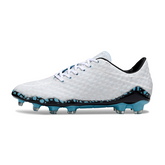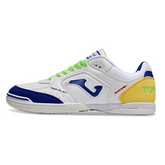Mais procurados
Produtos Populares!
Chuteira Campo Nike Phantom Hypervenom Elite FG Hydra Transform Pack
- €115,86
- €115,86
- (-0%)
- Unit price
- / put
Chuteira Campo Adidas F50 Elite FG Lamine Yamal Pack
- €120,08
- €120,08
- (-0%)
- Unit price
- / put
Chuteira Futsal Joma Top Flex 24 IC Brasil Pack
- €97,92
- €97,92
- (-0%)
- Unit price
- / put
- Football Boots
- Football Boots
- Go to Football Boots
-
Firm Ground (FG)
- Firm Ground (FG)
- Go to Firm Ground (FG)
- Adidas
- Mizuno
- Nike
- Puma
![]()
-
Turf (TF)
- Turf (TF)
- Go to Turf (TF)
- Adidas
- Mizuno
- Nike
- Puma
![]()
- Indoor (IC)
-
Multi Ground (MG)
- Multi Ground (MG)
- Go to Multi Ground (MG)
- Adidas
- Puma
![]()
-
Artificial Ground (AG)
- Artificial Ground (AG)
- Go to Artificial Ground (AG)
- Nike
![]()
-
Soft Ground (SG)
- Soft Ground (SG)
- Go to Soft Ground (SG)
- Adidas Trava Mista
- Nike Ponta de Aluminio
- Nike Trava Mista
![]()
-
Kid Boots
- Kid Boots
- Go to Kid Boots
- Campo (FG)
- Society (TF)
![]()
- Retro
![]()
- Shoes
- Shoes
- Go to Shoes
- Adidas
- Nike
-
New Balance
- New Balance
- Go to New Balance
- 9060
![]()
![]()
- Apparel
- Equipments
- Equipments
- Go to Equipments
- Boot Bag
- Balls
- Goalkeeper Gloves
- Socks
![]()
- Running Spikes
- Running Spikes
- Go to Running Spikes
- Nike
- Deals
- Pronta Entrega (Brasil)
- Pronta Entrega (Brasil)
- Go to Pronta Entrega (Brasil)
- Confira nosso estoque a pronta entrega:
-
Campo (FG)
- Campo (FG)
- Go to Campo (FG)
- Adidas
- Nike
![]()
-
Salão(IC)
- Salão(IC)
- Go to Salão(IC)
- Adidas
- Nike
![]()
-
Society (TF)
- Society (TF)
- Go to Society (TF)
- Adidas
- Nike
![]()
- Tênis
![]()
Diferences Between Cleats Sole

Can You Tell the Difference Between Football Boots?
And more importantly — do you know how to identify the right studs and outsoles when buying your next pair?
In this guide, VENI Football explains everything you need to know to avoid confusion between FG, SG, and AG boots for grass, as well as TF (turf) for synthetic pitches and IN/IC for indoor or futsal courts.
In professional football, every detail matters — from weather conditions and gear choice to the weight of the ball. That’s why choosing the right pair of boots for each surface is essential.
And remember — choosing the wrong sole type can easily cause damage to your boots. So here’s everything you need to know to pick the right studs for the best performance on the pitch.
If you see FG in a product name, it stands for Firm Ground — the most common and widely used type of football boot worldwide.
They’re designed for dry, firm natural grass (not wet conditions), with a higher number of shorter studs for grip and balance.
Still, there are many FG variations — with round, square, triangular, or bladed studs made of rubber or synthetic materials, in different heights and shapes.
Thanks to their comfort and versatility, FG boots are favorites among wingers and forwards, who need agility and quick changes of direction.
Players like Lionel Messi and Cristiano Ronaldo often wear FG boots for their mobility and adaptability to most pitches.
If you find SG in a product name, it means Soft Ground — designed for wet, muddy, or softer pitches.
SG boots feature fewer but longer studs, often made of metal (aluminum) or polyurethane, to provide maximum traction and stability.
They’re ideal for defenders, goalkeepers, and strikers who need more grip for sudden sprints and stops.
Some modern SG models even combine mixed stud patterns for better performance — and you’ll find these options at VENI Football.
However, SG boots are less common for attackers, as the longer studs can get stuck in the ground more easily.
They’re best suited for wet grass and defensive players needing firm footing.
AG, HG, or MG Studs (Artificial / Hard / Multi-Ground)
If you see AG, HG, or MG, these refer to Artificial Ground, Hard Ground, or Multi-Ground boots — all suitable for artificial turf or dry, hard natural surfaces with short grass.
These studs are shorter and wider, spreading the pressure evenly across the sole to enhance comfort and traction on compact terrain.
They’re ideal for synthetic or worn-out pitches, offering safety and durability.
When you see TF in the name, it means Turf — designed for synthetic grass, commonly known as society football in Brazil.
These outsoles feature many small rubber studs, made from the same material as the sole, providing great grip and joint protection.
They’re perfect for fast-paced, precise play on synthetic fields and help reduce injuries caused by overuse or instability.
Finally, IN or IC stands for Indoor Court, meaning futsal boots designed for hard indoor floors (wood or concrete).
They have flat, rubber outsoles for better traction and flexibility.
Lightweight and comfortable, these models allow fast movement and control — ideal for futsal’s dynamic pace.
If you’re new to futsal, VENI Football recommends choosing a model with excellent grip to boost your confidence and prevent slips.
- Choosing a selection results in a complete page update.















